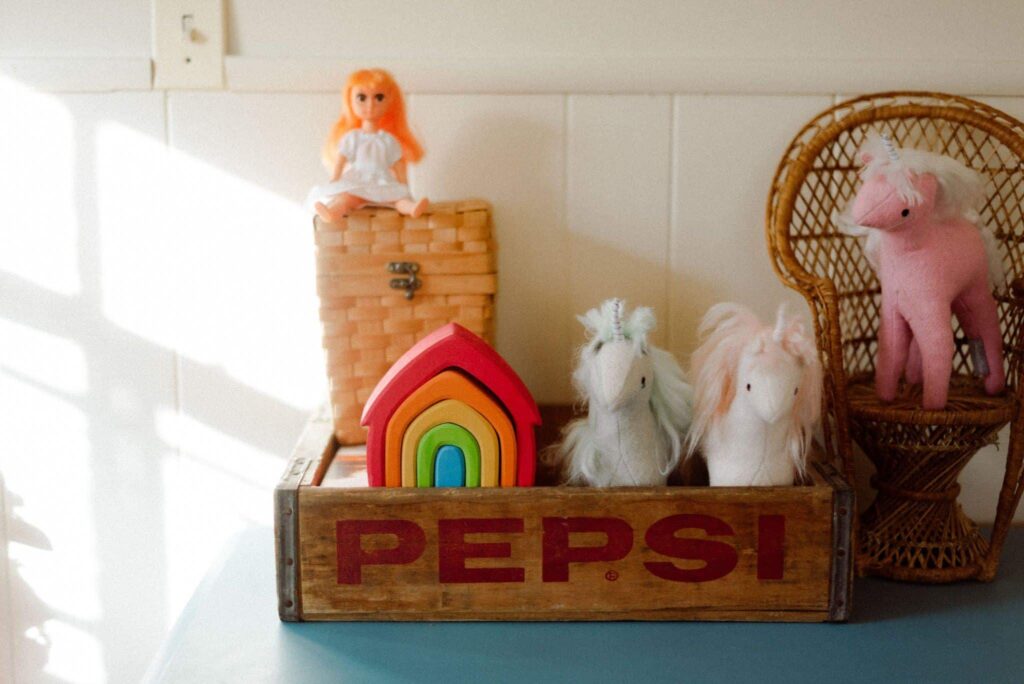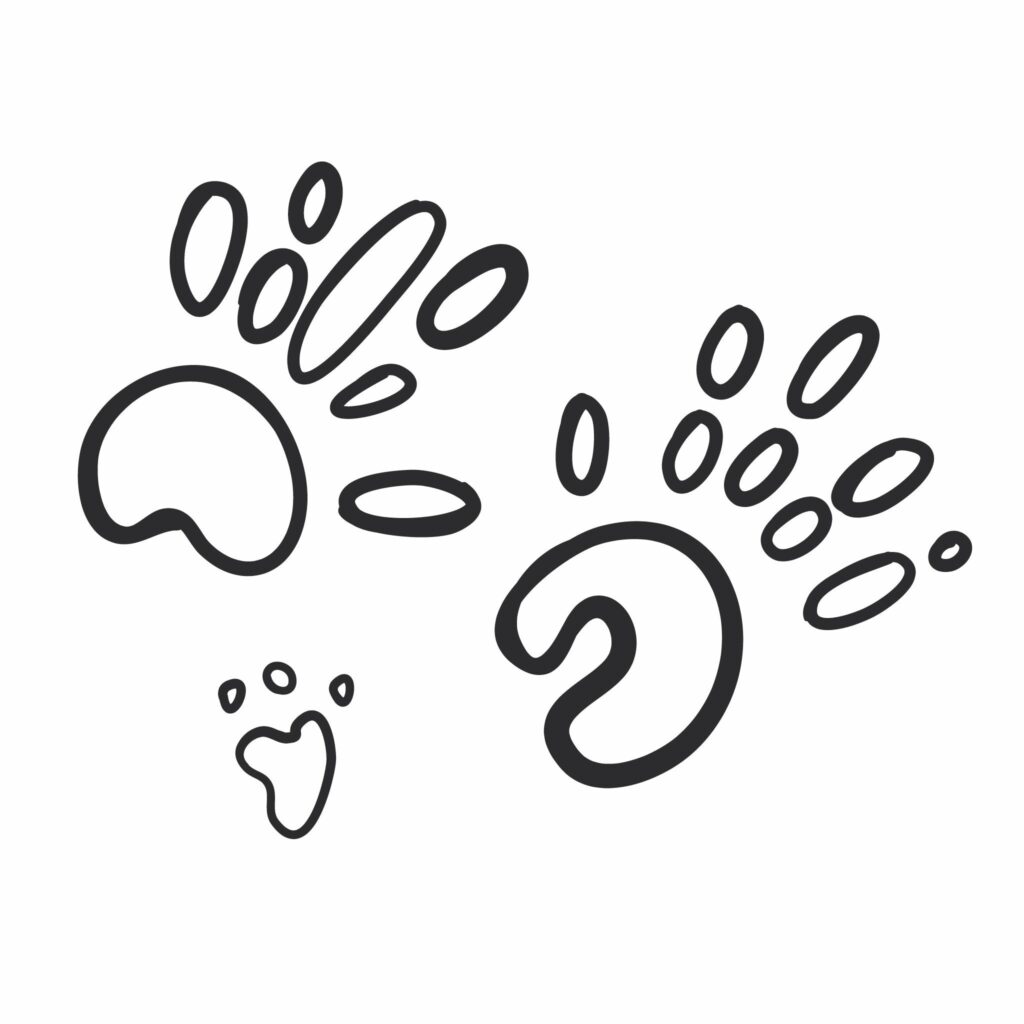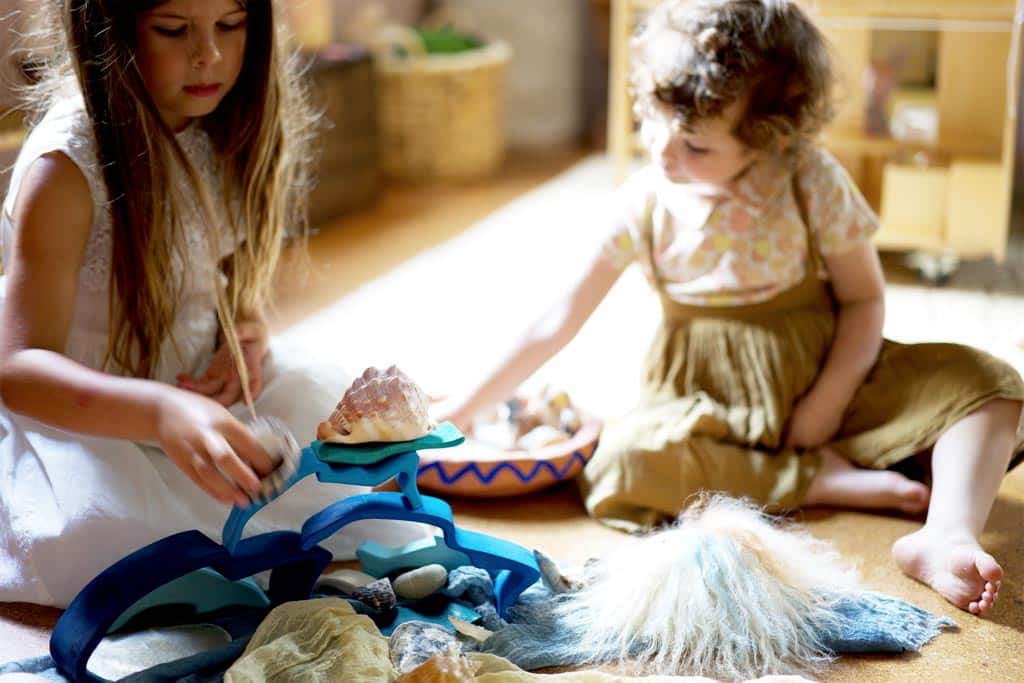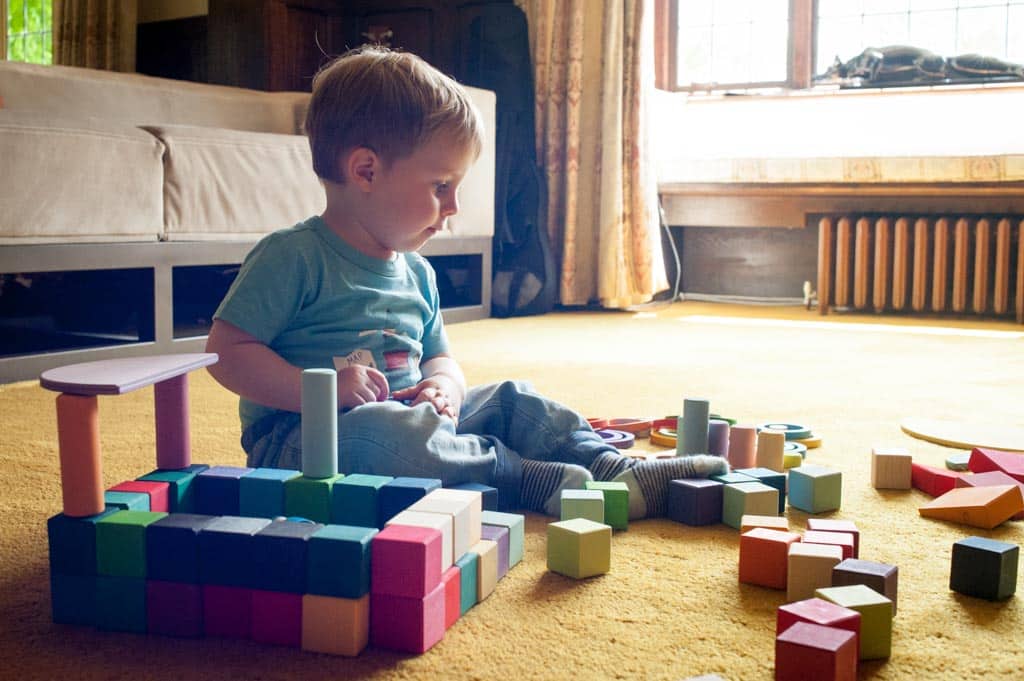Have you ever felt overwhelmed by toy clutter in your home? Ever felt exasperated that your child never seems to play with any of their toys? It doesn’t have to be like this! Through simple toy rotation, you can reduce clutter and increase your child’s creativity and focus. Read on to find out how:
Contents:
- What is toy rotation?
- What are the benefits of toy rotation?
- How do you decide which toys to rotate?
- What about bigger toys?
- How often should you do it?
- Where do you put the toys you are taking away?
- What if I have only got one of a certain type of toy?
- How many toys do you rotate at a time?
- Should I discuss toy rotation with my child?
- Summary
What is toy rotation?
Toy rotation is a simple solution to a common problem. Most children today have too many toys, and feel overwhelmed by choice. In toy rotation, instead of having all the toys in the house out at once, you divide them into smaller, more manageable groups and switch them around on a regular basis.
What are the benefits of toy rotation?
Apart from the obvious boon of greatly reducing clutter at home, there are a number of benefits of toy rotation for children. When you have all the toys available and accessible at all times, everything gets jumbled up and makes a big mess. There’s a time and a place for messy-play but it’s not an effective strategy for the kind of sustained, independent play that we want our children to engage in and be absorbed by.
Just like us grown-ups, children can find mess chaotic and unsettling, and have trouble focusing on their play in a hectic environment. They bounce around from one thing to another, bamboozled by choice and unable to stay with one toy for very long. They don’t get to practise doing an activity for any length of time as their attention is diverted to whatever has just caught their eye. And even with the best storage for toys at home, getting children to tidy them up at the end of the day becomes a gargantuan task they don’t want any part of.
By rotating a smaller, more thoughtfully-edited selection of toys, children get the chance to focus and play on a deeper level. Other benefits of toy rotating can also include a developed sense of patience and perseverance, heightened creativity as they learn to repurpose toys in different ways, and even an enthusiasm for tidying up since it is no longer such a big job.
Another happy side-effect of toy rotating for toddlers especially, is that you are usually able to declutter your play-space, as you edit and categorise more purposefully.
Finally, with fewer toys you are forced try more unusual combinations. You look for ways to increase the play potential of your toys.

How do you decide which toys to rotate?
Toy rotating is not a science and in fact any kind of toy rotation usually has a positive effect. If you have some cars out one day and put out a different set of cars the next, the second set (if they haven’t been seen for a while) will be played with as if they were new.
But things get even more interesting when instead of a second set of cars you can provide a different vehicle like a helicopter or a submarine. When thinking about how to categorise toys, a good tip is to think of the different types of toys almost like food groups, and try to ensure that something from each group is available. Here’s a table showing how you might do it (but remember, this needn’t be complicated and if you don’t always manage to get something from each group in, it’s really not the end of the world.)
| Toy type | Week 1 | Week 2 | Week 3 | Week 4 |
| Construction | Wooden blocks | Duplo | Train set | Marble run |
| Puzzles & Games | Matching | Sorting | Memory | Spot the difference |
| Loose parts | Toy loose parts (e.g. Grapat) | Natural materials | Manmade materials | Oversized pieces |
| Vehicles | Cars | Boats | Diggers & tractors | Helicopter/aeroplane |
| Play figures | Family | Jungle animals | Woodland animals | Sea animals |
| Soft toys | Teddy bear | Fairy | Mouse | Dog |
| Mark-making | Crayons | Chalks | Paints | Stamps |
The categories are designed to help you. It’s how teachers would do it in a preschool setting. If you don’t have the time or inclination to schedule a full rotation, you can get most of the benefits by simply putting most of your child’s toys away. Get something different out every now and again. Bonus points if you can come up with unusual combinations – this keeps things fresh for longer.
What about the bigger toys, like a play kitchen or a farm?
If a toy is sufficiently open-ended that it can form the basis for all kinds of play, there’s not really any need to rotate it. A three-year-old will probably enjoy having a doll’s house or farm to play with, some figures and a few blocks to extend the scene. The scene will change with her imagination and the scenarios she decides to work with (a play kitchen can be a cafe one day, a home-kitchen the next), so there’s probably not much need to rotate it out. This theory applies to almost any small-world setting (doll’s houses, farms, zoos, city maps) and toys that support role-play like baby buggies, play theatres or tea sets. We wouldn’t rush to rotate these types of toys, as they change with your child’s play.
How often should you do it?
You can rotate daily or weekly or even fortnightly. The only rule is that you leave the toys out for long enough that your child has the opportunity to explore their play possibilities fully, but not so long that boredom sets in. A week is usually a good length of time. But some toys merit longer stints than others. For example, a small-world scene like a farm or a city floormat, may provide days of fun, but threading materials could become boring by the afternoon. Observe your child at play and use your judgement to inform your decisions.
Where do you put the toys you are taking away?
This might sound like an odd question, but it’s actually quite important that your child doesn’t have easy access to the toys that are taking a break. We are all for child-friendly, easy-to-use toy storage, but if the toys on rotation are too visible and accessible, you might find they are distracted by them, and will want to get them out or pull them down if you turn your back for five minutes.
Our advice is out of sight, out of mind. Try to find a place that is well away from the toys they are playing with and don’t let them know where it is. A bedroom wardrobe or another cupboard away from view is ideal. If space is tight, simply making sure they are out of reach is a good start.
What if my child is really enjoying playing with a certain toy but it’s been out for a while and it’s time to rotate? If they ask to keep something specifically, we’re inclined to let them. This isn’t a rigid set of rules! And hopefully it means they’re inspired to do something with it. But use your judgement – are they really playing and exploring new possibilities with it, or repeating the same thing over and over? If that’s the case and their explorations seem to have run out of steam, maybe suggest a time limit and agree when a new toy can come out instead.

What if I have only got one of a certain type of toy?
The trick is to come at it, or the activity it represents, from a different angle every time. If for example, you only have one small train track set and your child really enjoys connecting the pieces and building the track, you could think about other ways to provide them with connecting opportunities, whether that’s threading beads or junk modelling with toilet rolls and sticky tape.
If it’s a toy with a number of pieces, as with a set of wooden blocks or a box of cars for example, you can edit the toy in different ways. Provide only the blue blocks one week and the red ones next week. Put out the race cars but not the emergency vehicles. It will require a little more thought at the start but will reap greater rewards as your child becomes more focused and engaged in their play.
Another option is to bring in toys from your local toy library or swap in toys with a friend who has something you don’t. Moving away from a sense of ownership to a more fluid relationship with toys and how they play with them, is very much in the spirit of rotation.

How many toys do you rotate at a time?
Only you can know how many toys is appropriate for your child and the space you have available. Recent figures suggest that in the UK the typical child owns around 240 toys, but parents think they play with about 12 ‘favourites’ (around 5% of their toys) on a daily basis. So the 5% could be a good place to start, but you may have siblings and other children to consider. However many you decide on, try to rotate all the toys at the same time. A good example is a 2 x 2 bookcase (the kind you find at Ikea), holding four baskets of toys. It is more effective to replace all four baskets at the same time. If you keep all your child’s toys in these baskets, you can easily swap new for old. If you are rotating four baskets at a time, try to offer four sets of toys that work well together, such as blocks, nested boxes, figures and vehicles. Four baskets of figures won’t offer any variety and boredom will soon set in. But pair toys with complementary ones and the play possibilities multiply exponentially. A manageable amount like this also helps to make tidying up fun for children. You can sing a tidying song or race to the finish together and make the whole thing fun.
What about Christmas toys or other toys with a very obvious theme like Halloween or Easter? Toy rotation is a great way to explore the calendar’s many celebrations and the changing seasons. Try creating a Christmas toy-rotation with festive mice, baubles for loose parts and crafts for making paperchains and snowmen. A summer-holidays rotation could include a box of sand, some safari animals and a bucket and spade for outside play. If you have the space and time to prepare them, keep these rotation ‘takeovers’ somewhere out of the way so they’re ready to go when you need them.

Should I discuss toy rotation with my child or is it best to do it while they’re asleep or at nursery?
Talking to your child about rotation will depend on their age and how easy they find the idea of toys being taken away and replaced. It’s good to give them agency and choice, but be aware that entering into lengthy negotiations about which toys they can have when, may undermine the process. Talk to them if you need to and explain the idea, but avoid getting into a big debate about it. Ideally, you should start rotating as early as possible and that way they are comfortable with the idea from an early age. And don’t forget, toy rotation is most often a delightful and exciting experience for children as they get ‘new’ toys to play with!
Final word
Toy rotation is a win-win process that clears mental and physical space for your child, helping them to develop focus and play more independently, while also helping you reduce clutter in your home. It’s not a science and there are no strict rules, you just need to try to make sure all the toy groups are represented (and if sometimes they’re not, it’s not the end of the world!) Here are some toy-rotation take-aways to help you:
- Start rotating early so your child becomes familiar with the process
- Identify the main toy groups and try to have something from each group in each rotation
- Don’t worry about rotating big toys or toys with an imaginative or small-world angle. These toys rotate themselves as they change with your child’s play.
- Keep the toys that are taking a break out of reach and if possible out of sight. Fewer distractions means greater focus.
- There are no rules about how many toys to rotate, but a less-is-more approach gives you greater scope for expanding later on.
- There are no rules about frequency, but try to keep to a regular rotation and to make sure they have time to really explore their toys fully. Once a week is a good place to start, but don’t let it become a chore. It’s OK to leave it a couple of weeks if you’re busy.
- Trust the process and relax in the knowledge that you are giving your child the chance to play more deeply with their toys.
Lastly, for more on this subject, read about how the environment is your child’s third teacher. It’s the idea that the playspace itself and the materials you fill it with have educational value. The space your child plays in matters.
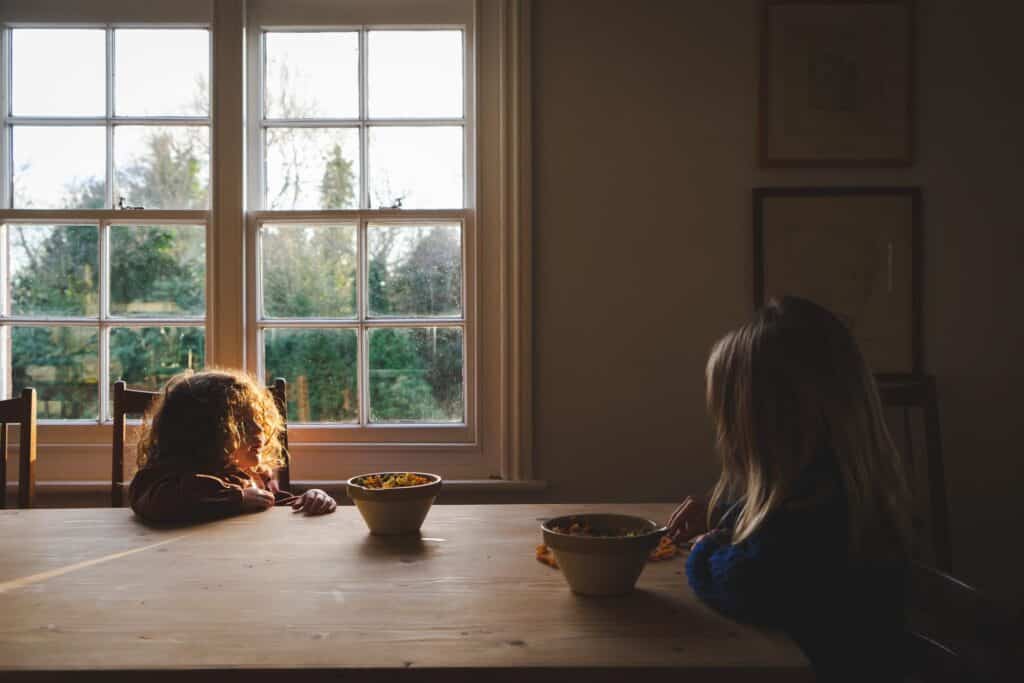
Have you run out of ideas?
What if you didn’t have to trawl the internet for play inspiration? What if your child’s freely-chosen activities were simple to set up, educational and deeply engaging?
How would that change things?
Our courses, A Year With My Child, Get Set Five and 5 Plus are designed for parents of toddlers, preschoolers and the over 5s and they’re packed full of fun and sensible advice.
Enter your email and we’ll send you free modules from each course. And then sit back and relax as your child learns to make her own fun.

